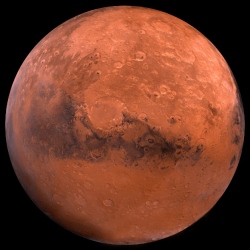
NASA has recommitted itself to landing humans on Mars by 2035, but has admitted that this is a project that will require the world to work together. NASA’s chief scientist Ellen Stofan gave a talk to the Royal Institution in London a fortnight ago, and video of the talk has now been released.
"This is not something any one nation can do on their own," Stofan said. "It’s something that humanity is going to do together." Stofan sees a Mars mission as a crucial part of the quest to answer the three questions she says turn up repeatedly in NASA’s goals: “Are we alone, how did we get here and how does the universe work.” Mars is particularly important for answering the other two, she argued, although she also talked about the potential for life on Europa and Enceladus.
The capacity of humans to collect the information we need to “understand Mars” still far exceeds anything rovers can manage, Stefan said. For this reason it is worth the vastly higher cost assocaited with sending people who need to be sustained on the journey. “We’re not sending astronauts to Mars, we’re sending scientists,” she said. “We’re not going there for the fun of it, we’re going to do science.”
President Obama announced plans for a mission to Mars in 2010 and continues to plan on that timeline, but the commitment has been questioned. Any program that will take so long to produce results is highly vulnerable to changes in priorities and funding cutbacks. Stofan herself noted “We’re trying to do something very bold over a long timespan, and that is something challenging in a world that usually doesn’t work of 5, 10, 20 year time horizons.”
Stofan says that before we can send people to Mars we need to know much more, particularly about the effects of microgravity on humans over such a long time and how to maintain a healthy diet over such a time with no opportunity to resupply..
